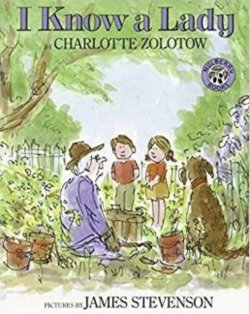Gareth B. Matthews

Review of I Know a Lady by Charlotte Zolotow (New York: Viking Penguin, 1986). Originally published in Thinking: The Journal of Philosophy for Children 7(2): 1.
”On our block,” this gentle story begins, “there is a lady who lives alone.” What follows that opening line is a child’s reflection on a neighbor friend. As James Stevenson’s lovingly evocative drawings make vivid to the reader, this woman, with her familiarly stooped shoulders and wistful smile, is a comforting presence to the neighborhood, including the neighborhood children.
The old lady gives her neighbors daffodils from her garden in spring, zinnias in summer, chrysanthemums in autumn and hollyberries in winter. She waves to the neighbor children as they go to school in the morning and smiles at them as they return home in the after noon. On holidays she does special things. At Halloween she invites the children in to eat apples she herself has candied. At Christmas she has them in to view her tree and eat the red-and green-sprinkled cookies she has baked. And at Easter she bakes· for them little cakes with yellow icing.
The old lady is sometimes seen to walk alone in the woods, to feed the birds and to put out cream for the cat that lives in the meadow. As Sally, the child narrator, notes proudly, the old lady knows by name both her and her dog, Matilda.
So far, then, we have the sketch of a reassuringly familiar grandmother figure, a sketch that celebrates the virtues of old age from a child’s perspective. The old woman is not judgmental, manipulative, overbearing, arbitrary, condescending or self-absorbed. To the contrary, she is supportive to neighborhood children in just the ways they can most appreciate. She maintains a friendship with them that enhances their well being as a natural gift of her own well- being.
The story gives us a model of one kind of human relationship, a mutually supportive and thoroughly non-competitive relationship between children and an adult. It is an ideal of one type of inter generational friendship.
Of course, not every adult in Sally’s life, or in the life of any other child, is free to cultivate a relationship of pure friendship. In a way, perhaps, Sally’s parents can also be her friends. But they have a responsibility for her upbringing that the old neighbor woman does not, and cannot, share. Something similar is true of Sally’s teachers. They have a duty to inspire, discipline, cajole, stimulate, drill and instruct her. Those duties do not belong, as such to pure friendship.
Sometimes teachers become good friends with their former students, as do, sometimes, parents and their grown-up children. But there are pitfalls. A grown-up child or former student who is still proving herself to teacher or parent, or a parent or teacher who has become too much invested in the success of a child or former student, is not open to the mutuality of real friendship.
Near the end of I Know a Lady Sally thinks a remarkable thought. Wondering what her old friend was like when she was a girl, Sally also wonders “if some old lady she knew had a garden and cooked and smiled and patted dogs and fed cats and knew her name.”
One reason Sally’s thought is remarkable is that it includes the realization hard for a child to manage, but then hard, too, for an adult-that old people are not essentially old, but were once, in their very own persons, children.
Another reason the thought is remarkable is that it encompasses, briefly and succinctly, the profound realization that lives fit together in sequentially overlapping patterns.
At the very end of the story Sally has this thought: If she were an old lady and the old lady were a little girl, she, Sally, would love her neighbor just as she loves her now.
One doesn’t have to be a philosophical skeptic about counterfactual conditionals, or a cynic about human nature, to find Sally’s confidence questionable. For anyone at all to be able to imagine an old woman as a young girl is hard enough. For a child to do that and, at the same time, imagine herself as an old woman, seems outrageously difficult. And who could know what anyone would be like after such great age transformations?
Still, one function of literature is to get us to try such thought-experiments, to entice us to, in Emily Dickinson’s phrase, “dwell in possibility.” Even when we don’t entirely succeed, the effort may be worthwhile.
The Sally on my own block is often amusingly bad at playing old lady to me as child. But when she carefully picks a dandelion and lovingly sticks it in my hair, the way in which she has succeeded is more important, many times over, than the obvious way in which she has failed.
